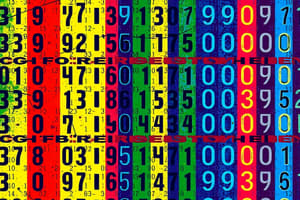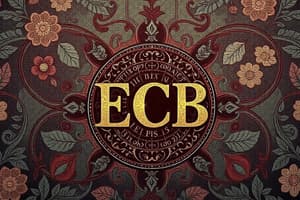Podcast
Questions and Answers
What type of encryption uses different keys for encryption and decryption?
What type of encryption uses different keys for encryption and decryption?
- Vernam Cipher
- Symmetric key encryption
- Asymmetric key encryption (correct)
- Caesar Cipher
Which type of cipher replaces each character with another character a fixed number of positions down the alphabet?
Which type of cipher replaces each character with another character a fixed number of positions down the alphabet?
- Substitution Cipher (correct)
- Vigenère cipher
- Vernam Cipher
- Hill Cipher
What does AES stand for in the context of cryptography?
What does AES stand for in the context of cryptography?
- Advanced Encryption Standard (correct)
- Advanced Encoding System
- Asymmetric Encryption Standard
- Altered Encoding Scheme
Which type of attack analyzes how differences in input can affect the resulting encrypted output?
Which type of attack analyzes how differences in input can affect the resulting encrypted output?
What must hold true for a One Time Pad (OTP) to be secure?
What must hold true for a One Time Pad (OTP) to be secure?
Which type of cipher operates on fixed-size blocks of data, rather than manipulating individual characters?
Which type of cipher operates on fixed-size blocks of data, rather than manipulating individual characters?
What property does AES shiftRows and shiftColumns step ensure according to the text?
What property does AES shiftRows and shiftColumns step ensure according to the text?
What is the main focus of Linear Cryptanalysis on block ciphers like DES, 3DES, and AES?
What is the main focus of Linear Cryptanalysis on block ciphers like DES, 3DES, and AES?
What does Differential Cryptanalysis study in relation to block ciphers?
What does Differential Cryptanalysis study in relation to block ciphers?
Which feature characterizes a Cryptographic Hash Function (CHF) based on the text?
Which feature characterizes a Cryptographic Hash Function (CHF) based on the text?
In Cryptographic Hash Function SHA-256, what does 'SHA' stand for?
In Cryptographic Hash Function SHA-256, what does 'SHA' stand for?
What is the primary goal of MixColumns in AES in conjunction with ShiftRows?
What is the primary goal of MixColumns in AES in conjunction with ShiftRows?
What is the main difference between ECB and CBC modes of operation in block ciphers?
What is the main difference between ECB and CBC modes of operation in block ciphers?
Why did the National Institute of Standards and Technology (NIST) replace DES with AES as the standard encryption algorithm?
Why did the National Institute of Standards and Technology (NIST) replace DES with AES as the standard encryption algorithm?
Which mode of operation in block ciphers results in identical ciphertext blocks when encrypting identical plaintext blocks with the same key?
Which mode of operation in block ciphers results in identical ciphertext blocks when encrypting identical plaintext blocks with the same key?
What made cracking the DES algorithm possible in the 1990s?
What made cracking the DES algorithm possible in the 1990s?
Which block cipher mode of operation partially depends on adjacent blocks during encryption?
Which block cipher mode of operation partially depends on adjacent blocks during encryption?
Why was DES originally practical only in hardware implementations?
Why was DES originally practical only in hardware implementations?
Flashcards
Asymmetric Encryption
Asymmetric Encryption
Uses different keys for encryption and decryption.
Caesar Cipher
Caesar Cipher
Replaces each character with another character a fixed number of positions down the alphabet.
AES
AES
Stands for Advanced Encryption Standard in the context of cryptography.
Differential Attack
Differential Attack
Signup and view all the flashcards
One-Time Pad (OTP)
One-Time Pad (OTP)
Signup and view all the flashcards
Block Cipher
Block Cipher
Signup and view all the flashcards
AES ShiftRows and ShiftColumns
AES ShiftRows and ShiftColumns
Signup and view all the flashcards
Linear Cryptanalysis
Linear Cryptanalysis
Signup and view all the flashcards
Differential Cryptanalysis
Differential Cryptanalysis
Signup and view all the flashcards
Cryptographic Hash Function (CHF)
Cryptographic Hash Function (CHF)
Signup and view all the flashcards
SHA-256
SHA-256
Signup and view all the flashcards
MixColumns in AES
MixColumns in AES
Signup and view all the flashcards
ECB and CBC Modes
ECB and CBC Modes
Signup and view all the flashcards
NIST and AES
NIST and AES
Signup and view all the flashcards
ECB Mode
ECB Mode
Signup and view all the flashcards
DES Cracking
DES Cracking
Signup and view all the flashcards
CBC Mode
CBC Mode
Signup and view all the flashcards
Study Notes
Asymmetric Encryption
- Asymmetric encryption uses different keys for encryption and decryption.
Caesar Cipher
- Caesar Cipher replaces each character with another character a fixed number of positions down the alphabet.
Advanced Encryption Standard (AES)
- AES stands for Advanced Encryption Standard in the context of cryptography.
Differential Attack
- Differential attack analyzes how differences in input can affect the resulting encrypted output.
One-Time Pad (OTP)
- For a One-Time Pad (OTP) to be secure, the key must be at least as long as the plaintext, never reused, and kept secret.
Block Cipher
- Block Cipher operates on fixed-size blocks of data, rather than manipulating individual characters.
AES ShiftRows and ShiftColumns
- AES ShiftRows and shiftColumns step ensures the mixing of columns and diffusion of rows.
Linear Cryptanalysis
- The main focus of Linear Cryptanalysis is on finding linear approximations of the block cipher's nonlinear components, such as S-boxes, in block ciphers like DES, 3DES, and AES.
Differential Cryptanalysis
- Differential Cryptanalysis studies how pairs of inputs with a fixed difference in plaintext produce a fixed difference in ciphertext in relation to block ciphers.
Cryptographic Hash Function (CHF)
- A Cryptographic Hash Function (CHF) feature is that it is deterministic, non-invertible, and collision-resistant.
SHA-256
- In Cryptographic Hash Function SHA-256, 'SHA' stands for Secure Hash Algorithm.
MixColumns in AES
- The primary goal of MixColumns in AES, in conjunction with ShiftRows, is to ensure diffusion of columns.
ECB and CBC Modes
- The main difference between ECB and CBC modes of operation in block ciphers is that ECB does not use an initialization vector (IV), while CBC does.
NIST and AES
- The National Institute of Standards and Technology (NIST) replaced DES with AES as the standard encryption algorithm due to DES's vulnerability to brute-force attacks.
ECB Mode
- ECB mode of operation in block ciphers results in identical ciphertext blocks when encrypting identical plaintext blocks with the same key.
DES Cracking
- Cracking the DES algorithm was made possible in the 1990s due to its small key size, making it vulnerable to brute-force attacks.
CBC Mode
- CBC mode of operation in block ciphers partially depends on adjacent blocks during encryption.
DES Original Practicality
- DES was originally practical only in hardware implementations because its computational requirements were too high for software implementations at the time.
Studying That Suits You
Use AI to generate personalized quizzes and flashcards to suit your learning preferences.




